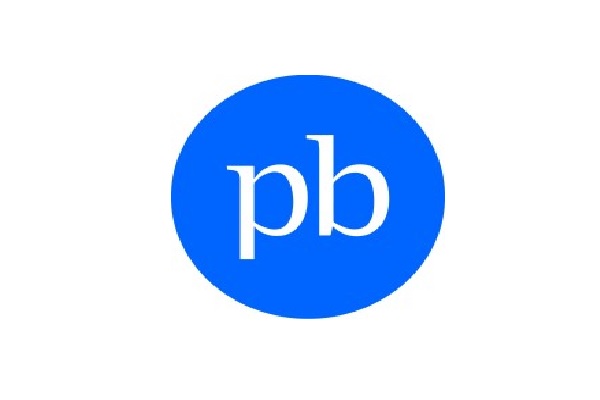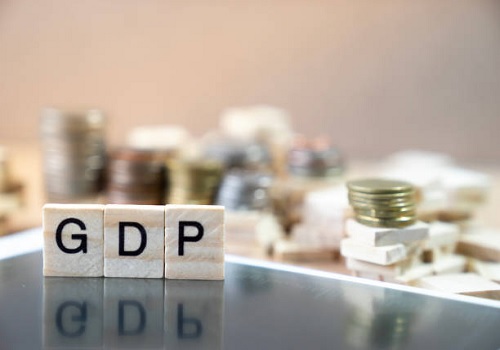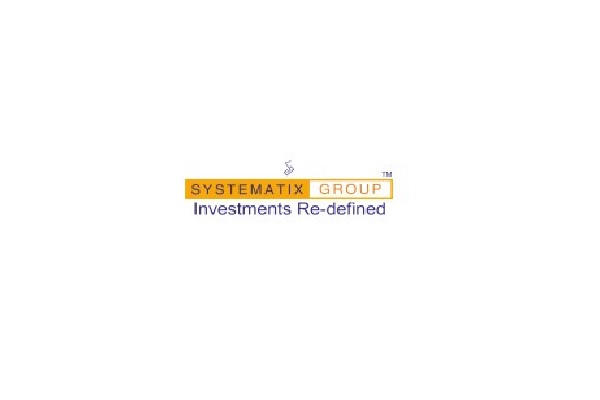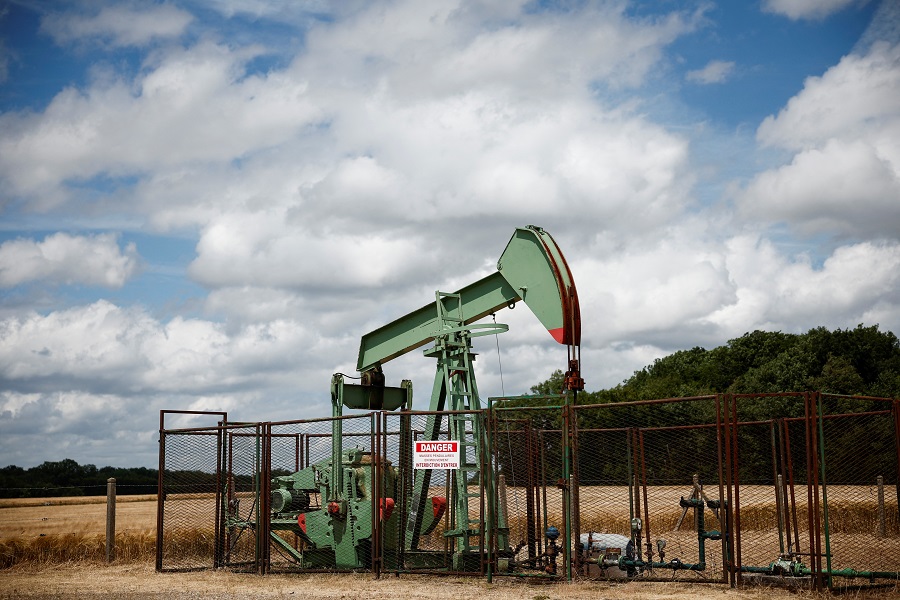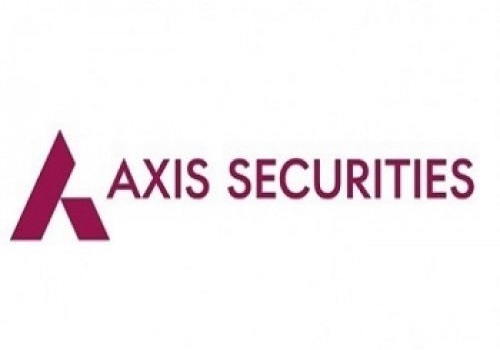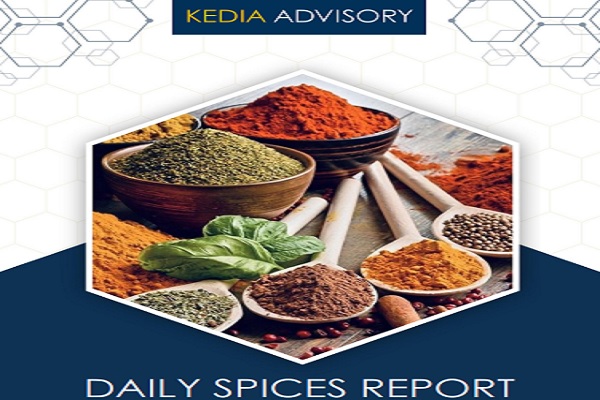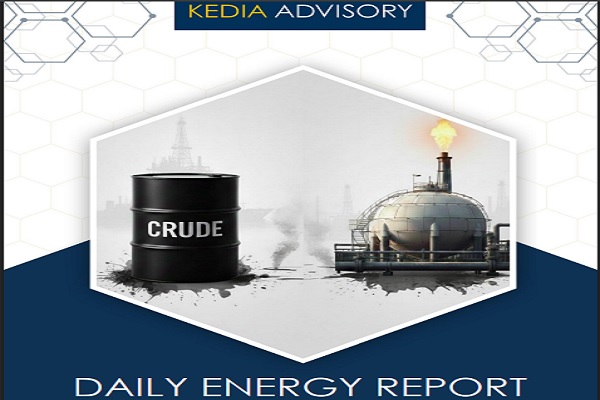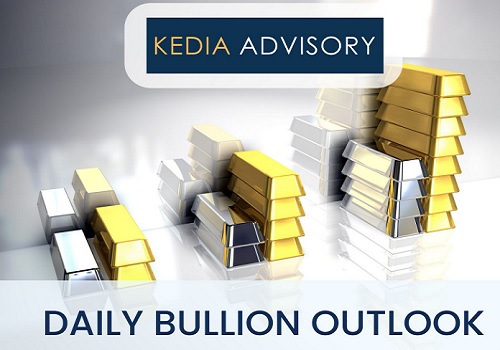Turmeric trading range for the day is 11588-11964 - Kedia Advisory
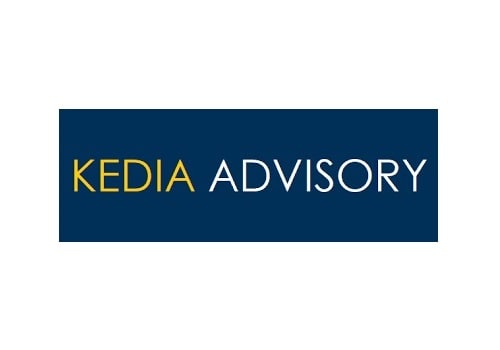
Gold
Gold prices rose 0.72% to 1,21,111, supported by global economic uncertainty and strong expectations of further US rate cuts. The ongoing US government shutdown, now stretching after multiple failed funding bills, has deprived markets of key economic data, reinforcing safe-haven demand. Traders are pricing in 25-basis-point Fed rate cuts in October and December with probabilities of 93% and 82%, respectively, further boosting gold’s appeal. Political instability in France and Japan has also added to the global risk sentiment. Investment demand strengthened after Goldman Sachs raised its December 2026 gold forecast to $4,900 per ounce, citing sustained ETF inflows and central bank purchases. Notably, China’s central bank increased its gold holdings for the 11th consecutive month, with reserves at 74.06 million ounces by September-end. In India, physical gold demand rose despite record prices, driven by festive buying, while gold and silver imports nearly doubled in September. Swiss exports of gold to China surged 254% to 35 tons, and to India rose to 15.2 tons, reflecting strong Asian demand. Meanwhile, exports to the U.S. dropped sharply amid import tariff uncertainties. Technically, the market is under fresh buying, with open interest up 1.14% to 15,964 lots. Gold has support at 1,20,240, below which it could test 1,19,370, while resistance is seen at 1,21,615. A decisive move above this level could push prices toward 1,22,120, suggesting continued bullish momentum in the near term.
Trading Ideas:
* Gold trading range for the day is 119370-122120.
* Gold gains supported by economic uncertainty and expectations of further US rate cuts.
* The US government shutdown continues with no clear resolution in sight after the Senate failed to pass funding bills for the fifth time.
* China's central bank increased its gold holdings for an 11th straight month in September.
Silver
Silver prices slipped 1.17% to 1,45,792 amid profit booking, after recently touching record highs fueled by safe-haven demand from the ongoing U.S. government shutdown and expectations of further Federal Reserve rate cuts. The prolonged budget impasse has delayed crucial economic data releases, including September’s jobs report, increasing uncertainty and boosting precious metal demand. Markets now almost fully price in two Fed rate cuts — one in October and another in December — which continues to support silver’s long-term bullish outlook despite short-term corrections. On the fundamental side, silver remains underpinned by a tight supply backdrop, with the Silver Institute projecting a fifth consecutive global deficit in 2025, estimated at 117.6 million ounces, though narrower than last year. Meanwhile, UBS raised its silver price forecasts to $52–$55/oz by mid-2026, citing strong investor interest and macroeconomic risks. Global silver ETP holdings surged to 1.13 billion ounces, with net inflows of 95 million ounces in H1 2025, pushing total holdings close to record levels. Retail investment demand in India grew 7% YoY, reflecting firm price expectations, while European demand continued its recovery from post-pandemic lows. Technically, the market is under fresh selling pressure, with open interest rising 20.93% to 26,019 lots. Silver has support at 1,44,390, and below that could test 1,42,995, while resistance lies at 1,47,490. A breakout above this resistance could propel prices toward 1,49,195, suggesting volatility but a broadly firm long-term trend.
Trading Ideas:
* Silver trading range for the day is 142995-149195.
* Silver dropped on profit booking after prices rose to record high amid ongoing US government shutdown and further rate cuts from Fed.
* Markets are now nearly fully pricing in a quarter-point Fed rate cut this month and another in December.
* Silver Institute projecting a global market deficit for a fifth consecutive year in 2025.
Crude oil
Crude oil prices slipped 0.20% to 5,480 amid persistent oversupply concerns and weak demand prospects, despite ongoing geopolitical risks that kept prices from deeper declines. According to JP Morgan, global oil inventories — including crude stored on water — rose every week in September, adding a total of 123 million barrels, underscoring a sharp increase in global stockpiles. Meanwhile, China’s aggressive crude reserve build-up further highlighted the market’s oversupplied state. On the geopolitical front, Russia’s Kirishi refinery halted operations after a drone attack, which may keep short-term supply conditions uncertain. Data from the U.S. Energy Information Administration (EIA) showed that crude inventories rose by 1.8 million barrels to 416.5 million barrels, above expectations for a smaller build. Gasoline stocks surged by 4.1 million barrels, while distillate inventories increased by 578,000 barrels, reinforcing the outlook of softening demand. Refinery utilization also slipped to 91.4%, signaling weaker processing activity. However, OPEC’s monthly report maintained its strong oil demand growth outlook for 2025, supported by a robust global economy and expectations of steady consumption into the year-end. OPEC+ output rose by 509,000 bpd in August, driven by quota hikes led by Saudi Arabia. Technically, crude oil is under fresh selling pressure, with open interest up 3.29% to 13,969 lots. Immediate support lies at 5,419, and a break below could drag prices to 5,358, while resistance is at 5,529, above which the market may test 5,578 in the near term.
Trading Ideas:
* Crudeoil trading range for the day is 5358-5578.
* Crude oil dropped amid persistent oversupply concerns and weak demand prospects.
* JP Morgan said that global oil inventories, have risen every week in September, adding 123 million barrels during the month.
* China, meanwhile, is building oil reserves sites at a rapid clip as part of a campaign to boost stockpiles.
Natural gas
Natural gas prices rose 2.43% to 307.3, supported by a decline in daily output despite lower flows to LNG export terminals and reduced demand forecasts for next week. Production in the Lower 48 U.S. states averaged 106.5 bcfd so far in October, down from 107.4 bcfd in September and 108.0 bcfd in August, with daily output recently hitting a four-month low of 104.4 bcfd. Although production had been strong in earlier months, allowing inventories to build up, output moderation now provides price support. On the demand side, warmer-than-usual weather through October 22 is expected to limit heating needs, though steady power usage offers some balance. LNG export flows averaged 16.1 bcfd early this month — up from 15.7 bcfd in September — but recently eased to 15.5 bcfd due to reduced intake at Cheniere’s Sabine Pass terminal. The U.S. Energy Information Administration (EIA) reported a below-average storage build of 53 bcf for the week ending September 26, compared to expectations of 67 bcf, bringing total inventories to 3.561 trillion cubic feet, about 5% above the five-year average. The EIA’s outlook projects record-high production and demand in 2025, with output seen at 106.6 bcfd and consumption at 91.5 bcfd, before both slightly ease in 2026. Technically, the market is under short covering, as open interest dropped 4.72% to 21,488 lots while prices gained. Support lies at 300.9, below which prices may test 294.4, while resistance is at 311.4, above which levels of 315.4 could be seen.
Trading Ideas:
* Naturalgas trading range for the day is 294.4-315.4.
* Natural gas gained on a decline in daily output.
* However, upside seen limited amid lower flows to LNG export plants and forecasts for less demand.
* Production in the Lower 48 states averaged 106.5 bcfd so far in October, down from 107.4 bcfd in September.
Copper
Copper prices rose by 0.72% to 996.25, supported by ongoing supply concerns from major producing regions such as Chile and Indonesia, though a stronger U.S. dollar capped further gains. Operational suspensions at Grasberg, Kamoa-Kakula, and Chile’s El Teniente mine are expected to tighten global supply, with analysts estimating a potential loss of around 591,000 tons through 2026. Chile’s copper output dropped 9.9% year-on-year in August following a production accident at Codelco’s mine, while China also reported a 5% decline in early September output, removing nearly 500,000 tons from the global market. Goldman Sachs and Citi have raised their copper price forecasts, citing tightening supply and a market deficit outlook for 2026, with Citi projecting prices could rise as high as $14,000 per ton next year. Aurubis’ record-high premium of $315 per ton for European customers further highlights tightening market conditions. Meanwhile, the International Copper Study Group reported a refined copper market surplus of 57,000 tons in July, compared with a deficit in June, though the surplus has narrowed compared to last year. On the demand front, Citi expects refined copper consumption to rise 2.9% next year to 27.5 million tons. Copper is witnessing short covering, as open interest dropped by 9.59% to 7,158 while prices advanced by 7.1. Immediate support is seen at 990.1, with a break below exposing 983.7, while resistance lies at 1001.4, and a move above could push prices toward 1006.3 levels.
Trading Ideas:
* Copper trading range for the day is 983.7-1006.3.
* Copper prices rose on concerns over supply from Chile and Indonesia.
* Chile's copper output fell 9.9% year-on-year in August after an accident at Codelco's flagship mine on July 31.
* Chile exported $4.39 billion worth in September, down 2.03% from the same month a year earlier.
Zinc
Zinc prices rose by 1.04% to 296.25, tracking LME levels above $3,015 per tonne for the first time this year amid mounting supply concerns. Although mined zinc output rose 6.3% year-on-year in the first half of 2025, refined production declined by over 2% due to smelter bottlenecks, notably in Kazakhstan and Japan, where Toho Zinc’s Annaka plant has shut down. Mitsui Mining and Smelting also plans a 6.6% cut in refined zinc output in the second half of FY2025/26. LME zinc inventories have dropped sharply—down 80% this year to just 48,825 tons—while cash LME zinc’s premium over the three-month contract surged to $51 a ton, signaling tight nearby supply. Meanwhile, expectations of U.S. rate cuts and a potential demand recovery in October are offering further support. However, subdued Chinese demand from the struggling real estate sector continues to limit the upside. On the global front, the International Lead and Zinc Study Group reported a 30,200-ton surplus in July, compared with a 21,100-ton deficit in June, though the overall surplus for the year remains smaller than in 2024. Production disruptions due to heavy rains in southern China and maintenance shutdowns could tighten supply going forward, partly offsetting rising output from Peru’s Antamina mine. Zinc is witnessing fresh buying as open interest increased 1.6% to 3,687 while prices gained 3.05. Immediate support is at 293, below which 289.7 may be tested, whereas resistance is seen at 298.4, with a move above likely to push prices toward 300.5.
Trading Ideas:
* Zinc trading range for the day is 289.7-300.5.
* Zinc rose tracking LME prices above $3,015 per tonne mark for the first time this year, amid compounding threats to supply.
* Output for Mitsui Mining expects a 6.6% annual decline in refined zinc output during the second half the financial year.
* Open stocks of high-grade zinc at the London Metals Exchange plummeted to 30,000 tonnes, compared to 171,500 at the start of the year.
Aluminium
Aluminium yesterday settled slightly higher by 0.11% at 261.65, supported by persistent supply concerns and steady demand recovery as operating rates improved. Prices found additional support amid tightening global supply and lower visible inventories. Goldman Sachs revised its aluminium outlook, projecting LME prices to average $2,350 per tonne in Q4 2026, down from the current $2,700, citing slowing demand and cost deflation, though near-term sentiment remains underpinned by U.S. rate cut expectations, dollar weakness, and constrained inventories. China’s manufacturing PMI remained below 50 for a sixth straight month, highlighting ongoing industrial weakness, while North American aluminium demand fell 4.4% year-on-year in H1 2025, pressured by weaker exports and tariff effects. Supply constraints remain in focus after Guinea revoked all bauxite mining licenses, potentially disrupting feedstock for Emirates Global Aluminium. Meanwhile, LME aluminium inventories dropped sharply by nearly 100,000 tonnes to 375,000 in early October, while Shanghai Futures Exchange stocks fell 2.4%. According to WBMS, the global aluminium market recorded a deficit of 119,900 tonnes in July and a cumulative shortfall of 985,300 tonnes from January to July 2025, reflecting strong consumption of 43.35 million tonnes against production of 42.37 million tonnes. Technically, the market is under short covering as open interest declined by 3.73% to 4,419 while prices rose slightly. Aluminium has support at 259.6, and below that, 257.5; resistance is at 262.9, with a potential move toward 264.1 on further buying.
Trading Ideas:
* Aluminium trading range for the day is 257.5-264.1.
* Aluminium gains supported by both supply concerns and strong demand as operating rates improve.
* Support also seen due to persistent threats to supply.
* Goldman Sachs cuts 2026 Q4 LME price forecast to $2,350/T from $2,700.
Turmeric
Turmeric prices settled slightly higher by 0.12% at 11,794 as reports of crop damage due to heavy rainfall in key producing regions, particularly Nanded, where nearly 15% of the crop area has been affected, lent support to prices. However, gains were limited amid expectations of higher acreage this season, aided by favorable rainfall during sowing. The area under turmeric for 2024–25 is estimated at 3.30 lakh hectares, up 10% from the previous year’s 3 lakh hectares, while dry weather conditions are currently supporting timely planting operations. Market sentiment also remained firm as turmeric stocks with farmers in Warangal are almost exhausted, and no new arrivals have been reported over the past few days. In Duggirala, new crop arrivals continue to attract strong buying interest, with fresh stock commanding a premium over old inventory due to better quality. Market activity remains active, with 50–55% of the new crop already traded and daily arrivals steady at 1,000–1,200 bags. On the export front, turmeric shipments rose 2.29% year-on-year during April–July 2025 to 63,020 tonnes, while July exports grew 9.31% compared to June. In the spot market at Nizamabad, prices fell 1.2% to 12,755.5. Technically, the market is under short covering as open interest declined by 13.79% to 8,130. Turmeric has support at 11,690, and below that at 11,588, while resistance is seen at 11,878 and 11,964 on the upside.
Trading Ideas:
* Turmeric trading range for the day is 11588-11964.
* Turmeric gains as recent rainfall has caused damage to standing turmeric crops in major growing regions.
* Recent heavy rainfall in Nanded has adversely affected the region's turmeric cultivation, damaging approximately 15% of the crop area.
* While upside capped amid increase in acreage due to favourable rains during the current sowing season.
* In Nizamabad, a major spot market, the price ended at 12755.5 Rupees dropped by -1.2 percent.
Jeera
Jeera prices yesterday remained largely flat, settling marginally higher by 0.03% at 18,950 amid weak domestic and export demand following the conclusion of the retail season. Downside support was seen after the GST council reduced the GST rate to 5%, which is expected to bolster FMCG exports and domestic consumption. Prices remained under pressure due to ample supplies and tepid overseas interest, as current export demand is being met from existing stocks. Farmers are estimated to still hold around 20 lakh bags of cumin, of which only 3–4 lakh bags are likely to be traded by the season’s end, leaving a carry-forward stock of approximately 16 lakh bags. The current season is expected to witness similar production levels to last year, supported by favorable crop conditions and good sowing. Production in India is estimated at 90–92 lakh bags, with Gujarat contributing around 42–45 lakh bags and Rajasthan 48–50 lakh bags. Jeera exports during April–July 2025 declined by 19.81% to 73,026 tonnes compared with 91,070 tonnes a year ago, while July exports fell by 20.83% year-on-year to 13,778.6 tonnes. In the Unjha spot market, prices fell by 0.77% to 18,909.65. Technically, the market is under short covering with open interest down 7.59% to 2,847. Support is seen at 18,880 and below that at 18,810, while resistance is likely at 19,050, and a move above could see prices testing 19,150.
Trading Ideas:
* Jeera trading range for the day is 18810-19150.
* Jeera settled flat due to weak domestic and export demand.
* In July 2025 around 13778.60 tonnes of jeera were exported as against 16,322.06 tonnes in June 2025 showing a drop of 15.58%.
* GST council lowers GST rate to 5% which will support FMCG exports & domestic demand.
* In Unjha, a major spot market, the price ended at 18909.65 Rupees dropped by -0.77 percent.
Views express by all participants are for information & academic purpose only. Kindly read disclaimer before referring below views


